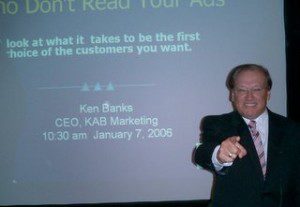 I was talking recently with a senior marketing executive with one of the country’s top retail chains about an upcoming presentation that I was scheduled to give in San Antonio (see photo above). During the course of our discussion, I asked her if she had given any presentations lately and her response was that “Absolutely not. Our company has a firm policy which prohibits executives making any speeches or participating in any discussions about the company’s plans or activities.” The rationale was that all this did was give the competitor’s more information than they should have. Having done a lot of speeches in my retail days, I was surprised since I always felt there may be a potential investor and certainly potential customers in the audience and that the information was always limited to facts that any good competitor would have been aware of if they were monitoring the marketplace on a regular basis.
I was talking recently with a senior marketing executive with one of the country’s top retail chains about an upcoming presentation that I was scheduled to give in San Antonio (see photo above). During the course of our discussion, I asked her if she had given any presentations lately and her response was that “Absolutely not. Our company has a firm policy which prohibits executives making any speeches or participating in any discussions about the company’s plans or activities.” The rationale was that all this did was give the competitor’s more information than they should have. Having done a lot of speeches in my retail days, I was surprised since I always felt there may be a potential investor and certainly potential customers in the audience and that the information was always limited to facts that any good competitor would have been aware of if they were monitoring the marketplace on a regular basis.
Unfortunately, in their quest to preserve confidentiality, many stores don’t restrict their communications only to the public or the trade. Often, they are very closed-mouth to their own employees. Shelley Broader, President/COO of SweetBay/Kash ‘n Karry Markets in Florida, recently spoke to a group of executives in Tampa Bay. In that presentation, she touted the fact that the company—which is in the midst of a major re-branding effort—is extremely open and “shares every bit of legally available information she can with the press, colleagues and the competition.” She said: “ What’s more dangerous? My competition knowing my plan or my 10,000 employees NOT knowing my plan?”
Amen, Shelley! Unfortunately, so many companies, especially retailers, spend millions of dollars and countless hours, developing a communications plan to insure that their customers understand their brand strategy. Then, they spend barely nothing more than a video or memo to explain it (usually only once) to their employees in the field. No wonder the customers are often disappointed when they visit the store and find that it’s the same as it always has been or not as what they expected from the advertising that they saw, which enticed them to visit the store. Stores must be diligent about having a comprehensive and ongoing communications plan about the brand strategy to insure that the employees, especially at store level, live up to the brand every day.
A few years ago, I was in Kmart to get a fishing license for my annual bass fishing outing (Kmart was the only place nearby that sold them at the time, and as usual, I left this important task until the night before I was supposed to leave for the river.) Anyway, at the time Kmart was spending millions re-introducing itself at Big Kmart and spending millions on ads with even the late Bob Hope appearing in one of the TV spots. While waiting for my license to be filled out, the salespeople (Ann and Myrt—two 60 -year olds who certainly didn’t seem to be experts on any sporting goods, much less a fishing license) were conversing back and forth. So I asked them what they thought of the new “Big Kmart” that they worked for. They looked at each other wondering what I was talking about. Then Myrt said: “I don’t know. Pretty much the same old, same old, right Ann? Oh, we did get a new sign outside and some new badges.” That was it. No wonder the re-branding was so successful! The marketing dollars were all wasted and the Wal-Mart down the street continued to gain market share. To live up to the brand, employees have got to know what that brand means to them and to their customers.
What do you think? Happy New Year.
Ken

Recent Comments